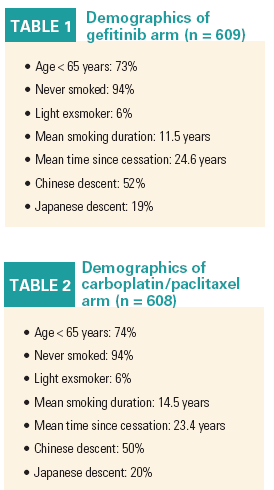Gefitinib changes first-line Rx for lung ca in Asian pts
The EGFR tyrosine kinase inhibitor gefitinib (Iressa) should be considered a first-line treatment option for nonsmoking Asian patients with adenocarcinoma of the lung, according to results from the large Iressa Pan-Asia Study (IPASS) conducted at the Chinese University of Hong Kong.
The EGFR tyrosine kinase inhibitor gefitinib (Iressa) should be considered a first-line treatment option for nonsmoking Asian patients with adenocarcinoma of the lung, according to results from the large Iressa Pan-Asia Study (IPASS) conducted at the Chinese University of Hong Kong.
EGFR inhibitors are indicated for second-line treatment of advanced non-small-cell lung cancer (NSCLC), but the IPASS study showed outcomes to be better with gefitinib first line than with standard chemotherapy in the population studied. This might be explained by the fact that about half the Asian nonsmoking population has tumors with EGFR mutations, according to Tony Mok, MD, a professor of oncology at the Chinese University.

Conducted in nine Asian countries, the IPASS trial included 1,217 chemonaive patients with stage IIIB/IV NSCLC of adenocarcinoma histology who were never-smokers or light exsmokers. The majority of patients were women, in keeping with the gender proportion of nonsmoking Asians, he explained (see Tables 1 and 2).
Patients were randomized to gefitinib 250 mg/d or to six cycles of chemotherapy with carboplatin/paclitaxel.
Oral treatment with gefitinib achieved superior progression-free survival, compared with chemotherapy, producing a 26% reduction in risk that was highly significant (P < .0001) and that exceeded the study’s primary endpoint of noninferiority. At 22 months, 74.4% of the gefitinib arm had progressed, compared with 81.7% on chemotherapy.
Outcomes differed according to EGFR mutation status. Patients with mutations had the most benefit from gefitinib, with a 51% reduction in progression (P < .0001), whereas those patients without EGFR mutations responded better to chemotherapy (P < .0001).
“EGFR mutation status was a strong predictive biomarker for the effect of gefitinib, compared to carboplatin/paclitaxel,” Dr. Mok said.
Also with gefitinib, response rates were significantly higher, quality-of-life scores were better, and tolerability was better, though symptom improvement was similar for the groups. At 22 months follow-up, survival data are not yet mature, but one-year overall survival was 68% with gefitinib and 64% with chemotherapy; median overall survival was 18.6 months and 17.3 months, respectively. Subsequent treatment post-study may dilute any differences in survival, he pointed out.
Frederico Cappuzzo, MD, of the department of medical oncology at the Instituto Clinico Humanitas, Milan, said that in order to translate the findings to Western populations, he would like to see a confirmatory trial with a more robust control group, perhaps receiving a regimen that contains bevacizumab (Avastin). Dr. Cappuzzo acknowledged, however, that he believes “gefitinib is certainly not inferior to six cycles of carboplatin/paclitaxel in Asian adenocarcinoma female never-smokers with EGFR mutations.” He added that the findings “certainly support the sequential use of EGFR inhibitors.”
Results of the IPASS study are important for “educating us regarding the underlying molecular biology which dictates different tumor behavior from one patient to the next,” commented David R. Gandara, MD, director of the Thoracic Oncology Program at the Sacramento-based cancer center at the University of California, Davis.
“Although this study was conducted completely in Asia, in a way, that fact makes the outcome even more extraordinary. The incidence of EFGR tyrosine kinase domain mutation was over 50% in this trial,” Dr. Gandara said. “This factor dictated patient outcome under the influence of gefitinib or chemotherapy.
Newsletter
Stay up to date on recent advances in the multidisciplinary approach to cancer.